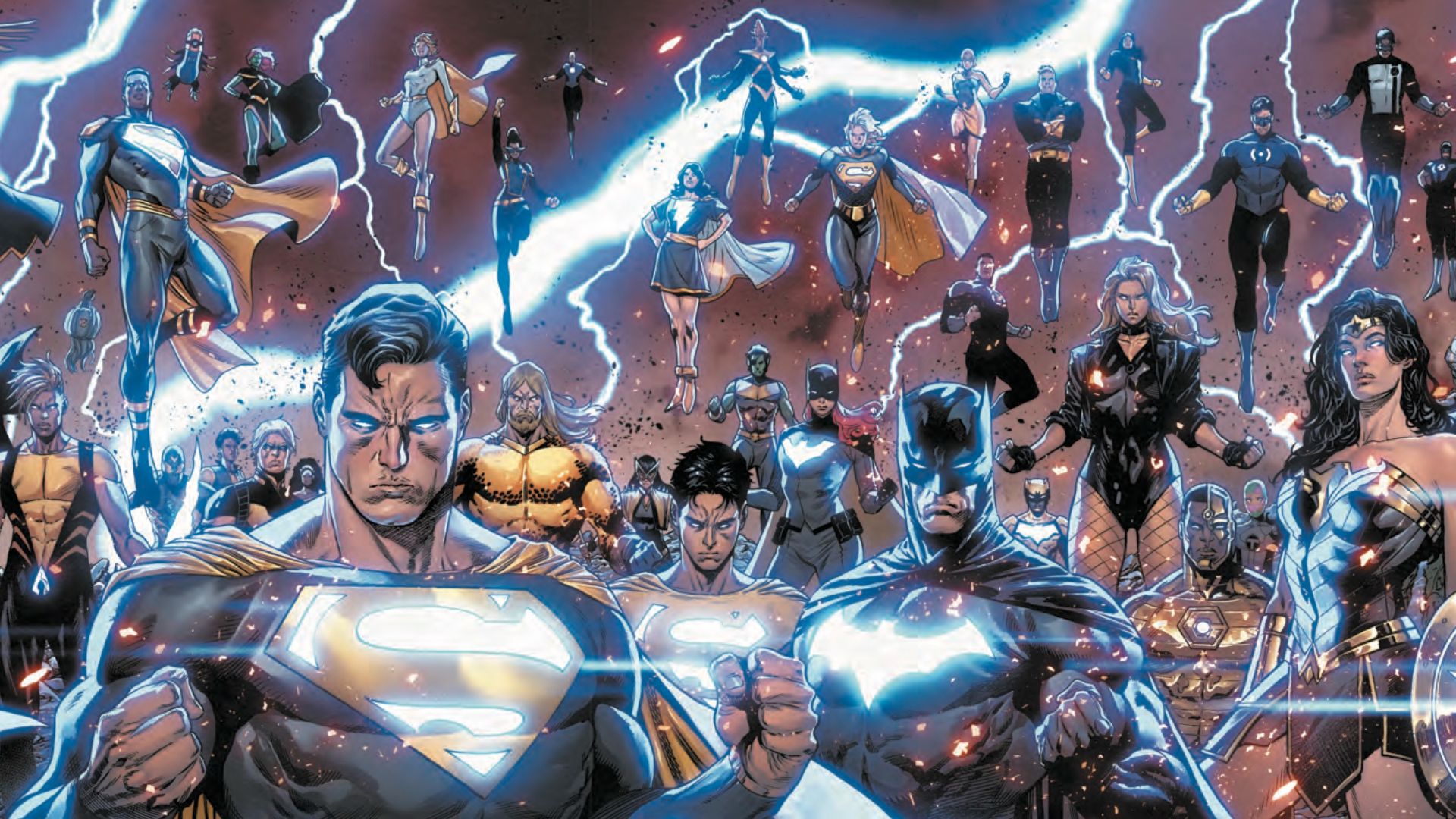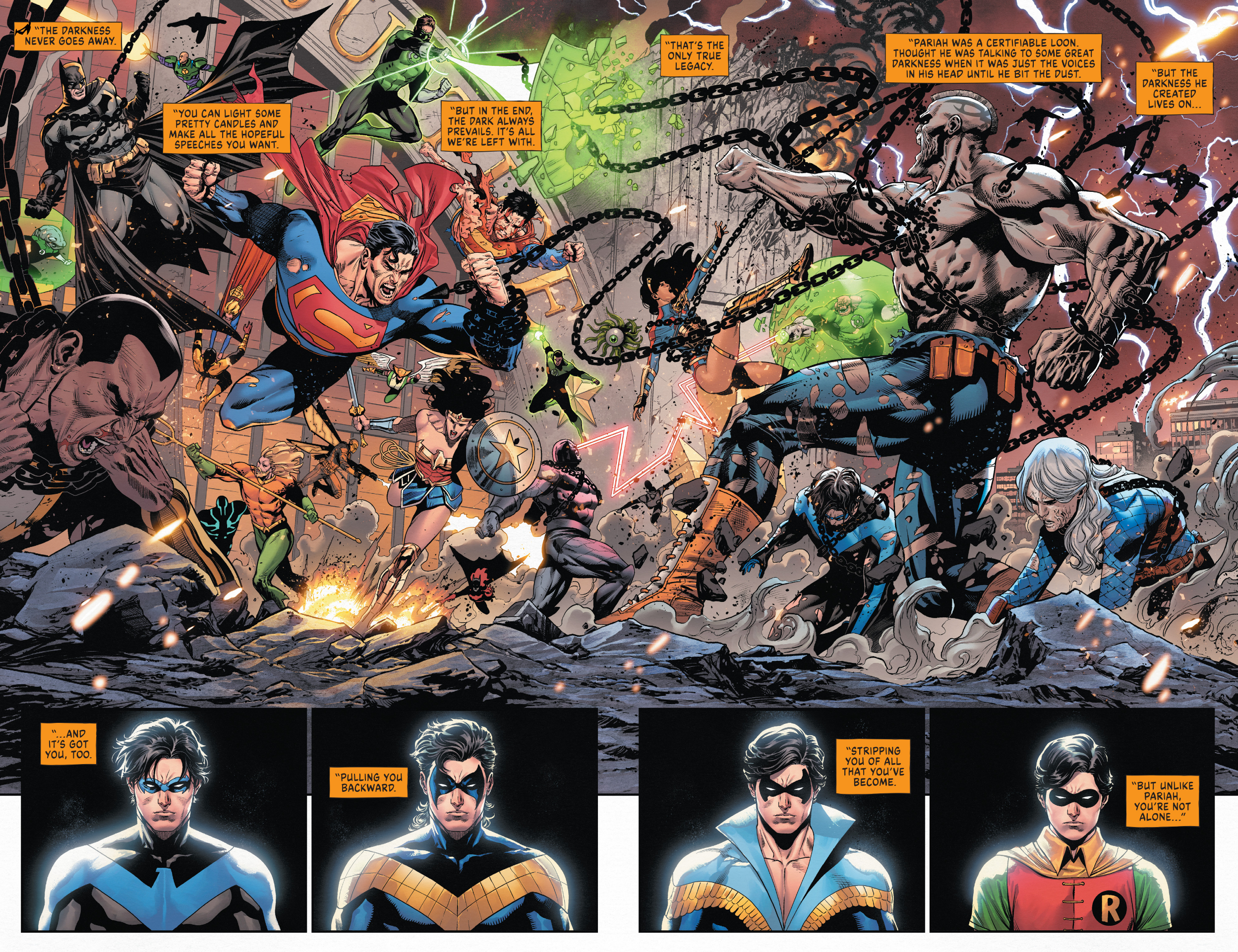Dark Crisis on Infinite Earths #7 paves the way for a "bright and positive" lighter tone DCU
Plus Nightwing is the "the boss" and who is Peacewrecker?

It all ends here.
Pariah's summoning of the Great Darkness, the temporary deaths of the Justice League members, and Deathstroke's madness all come to a head in the final issue of Dark Crisis on Infinite Earths #7, on sale December 20.
The finale features a script by Joshua Williamson; art by Daniel Sampere, Jack Herbert, Giuseppe Camuncoli, Cam Smith, and Rafa Sandoval; colors by Alejandro Sánchez, Alex Guimarães, Romulo Fajardo Jr., and Matt Herms; and letters by Tom Napolitano.
Ahead of the issue's release, Newsarama spoke to Williamson and Sampere about their historic efforts in closing out one of the largest DC events in recent memory; read on to hear what they had to say. But be warned, spoilers for Dark Crisis #7 follow.

Grant DeArmitt for Newsarama: Well, here we are. The Dark Crisis on Infinite Earths' finale. My first question to both of you, Joshua and Daniel, is: what are you drinking?
Joshua Williamson: Oh, coffee. Because I have so much more work to do. It never stops. You always think for a moment, 'Well, on this day I will rest.' But no.
You know, when people ask about how you feel about things, sometimes it's hard to reflect on these moments because you're often already in another space. By that time, I'm thinking this is already over in my brain. I'm already thinking about the end of 2023 and going into 2024. It's hard to sometimes slow down and be like, "Oh yeah, I should reflect on this emotionally a little bit."
Comic deals, prizes and latest news
Get the best comic news, insights, opinions, analysis and more!
But what's your question? Coffee. That's what I'm drinking.
Daniel Sampere: Yeah, on my side it’s coffee too. But in a different way, because today has been my first day of work. I had one month’s vacation after finishing the last issue. So I'm fresh, I'm great and ready to work again.

Nrama: Back on the horse! If you were ever really off it. So Daniel, let me ask you about the cover for Dark Crisis #7, which is Nightwing surrounded by Infinite Earths. Now that the issue is out, can you tell us what that image means?
Sampere: It's just a representation of some things that are important in the story. I saw many people on Twitter saying, "Nightwing has powers? How is that possible?" But it's just a representation of Nightwing in the center of darkness. The darkness is spreading across the multiverse and Nightwing projects light because he's light fighting against it.
So it was just a representation of concepts, nothing about Nightwing having powers. Sometimes covers are just representations of something, but not not the actual meaning, you know? It was like that; Nightwing with the light among all the darkness that's spreading across the multiverse.
Williamson: From the start, we had this idea that Nightwing was going to be this light. Bruce says in this issue that it was never about a candle [Williamson is referring to the candle Batman used to receive Dick Grayson’s oath of loyalty]. It was you; you're the light, in the darkness.
And that's all this was. It was a representation of all of this darkness happening on the Infinite Earths. This moment, like Nightwing, is that light that shines. That's a big part of the issue. So yeah, it was really funny when that cover went out and I mean, you know, people were like, "Oh no, Nightwing’s going to die!" And like, oh my God, I would never.

Nrama: Never say never!
Williamson: I mean, knock on wood. That's a conversation for another day. But, we also saw people saying that he had Doctor Manhattan powers because of the blue light. It’s like, well, no, he wears blue. Like, it's silly, you know? But at the same time, it's beautiful. I like the speculation and I think that's what you want to get to at the end of the day, is people talking about it.
Nrama: On that subject, Joshua, how has Dark Crisis changed Dick Grayson? What's Nightwing’s worldview after this issue?
Williamson: I think there was a part of Nightwing that was still waiting for permission to be this person. And Tom Taylor might totally disagree with me on this; you should read Nightwing #100 when it comes out in a month. But I think there was a part of him that needed to accept something that we all knew, right? I think Bruce knows. Superman knows and Diana knows; everyone kind of knows it's about Nightwing.
He's no longer just the son. He's no longer the sidekick. He is something bigger than that, but he's still waiting for permission to take on that role. You could see it in this story; here was a part of him that was rejecting that role, that wasn't really sure if he was ready to be the boss. I think that's where he's at now, where it's a bit more of him understanding that role and fully taking responsibility for that role moving forward.

That's some of the stuff you'll see in Nightwing #100. He has some conversations with people about what he wants to do in the future. But yeah, I think that was it. I think there was just a part of him that was always still waiting for permission to suddenly be that. It's like how, back in the day, he wanted Bruce to ask him to be Batman.
Nrama: When was that?
Williamson: Post-Knightfall. There was a part of Dick that was confused by the idea that Bruce gave Batman to John Paul. Tim Drake or Bruce, I can't remember, says something like, 'You're your own man now,' and Dick is like, 'Well, yeah, but I would have liked to be asked to be Batman.' There’s still this level of stuff that's going on.
At this point, Dick doesn't need to be Batman to be the leader of the Justice League. He doesn't have to take that step up; that isn't the next thing for him. He's recognizing things we've all known this whole time; that he represents legacy in the DCU. And now he's the one that's going to continue leading the DCU forward.
Nrama: One last Nightwing question. Daniel, there's a sequence in this book within Dick Grayson's mind, with him and Slade Wilson in their original costumes. Was that George Pérez-inspired? I know his influence has been so important to this book.
Sampere: Yeah, the designs are his. We wanted to go back to the look of the first time they met. These were the designs from the New Titans, just from me reading my copy again. Having the chance to draw these designs, these characters looking that way, was super exciting.

I was looking into a lot of references from George to see how he played with these characters, how they look. Some people, when they saw the previews, told me that it reminds them of George's style, but at the same time mixed it with mine.
Williamson: We did that to work on two fronts. You want to go back to the beginning with these two characters, and it's also a commentary on what the Darkness does, and what this fight against legacy is like. Deathstroke says it's pulling everything backwards. So it's pulling Nightwing backward. It's stripping away all of his accomplishments, all these things that he's done, and it's turning him back into being the kid. It’s stripping away all these pieces of legacy and all the growth, because to me, that's what the Darkness is always about, is trying to make things go back backward all the time.
The idea of growth is very much against the Darkness, and there was a conflict between Pariah and the Darkness over that idea. That was part of why we were like, 'well, let's bring it all back.' There was definitely a cool visual component. We both really loved George and it was like, well, then let's also say something about this moment where Deathstroke and Nightwing are having this fight, but they've been stripped away of all the growth they've had.
Daniel does an amazing job on every page, where I think he's doing two jobs at once. He's doing the very literal, 'this person is punching this person,' but at the same time, he's telling an emotional story that is not as literal. There's a moment in this issue where Black Adam is on one knee and he's telling Deathstroke, 'I will never move.' Now, there's the idea that you can have Black Adam on one knee, which normally is submissive, but in this moment, it was triumphant. I think Daniel does a lot of stuff like that throughout, that works on two levels.

Nrama: Alright, I want to get into a little bit of spoiler territory now. In the epilogue of Dark Crisis #7, we meet a group called the Council of Light, who are conversing with Amanda Waller, Peacemaker, and three new characters we haven’t met yet. Who are these three characters?

Williamson: I can tell you one of their names. The character with Peacemaker, the woman dressed like him; her name is Peacewrecker. That's the most I can tell you about her now but, hey, that's her first appearance.
Nrama: That’s a great tease. Okay, I know we’re running out of time, so this last question is for both of you: How do you think that DC storytelling is going to change, post-Dark Crisis? Daniel, let's start with you.
Sampere: This is a hard question. I'm doing some tricks here because I kind of know what direction DC wants to take, I just don't know if I can say more or less the mood that DC wants to talk about. It's going to be… I think it's going to be bright and positive. I think that's all I can say.
Williamson: Yeah, we really want to do a much lighter tone. But I think, you know, sometimes the light can get so bright that it burns.
Want to know what’s next for the DC Universe? Check out Newsarama’s look at the publisher’s upcoming Lazarus Planet event.

Grant DeArmitt is a NYC-based writer and editor who regularly contributes bylines to Newsarama. Grant is a horror aficionado, writing about the genre for Nightmare on Film Street, and has written features, reviews, and interviews for the likes of PanelxPanel and Monkeys Fighting Robots. Grant says he probably isn't a werewolf… but you can never be too careful.


